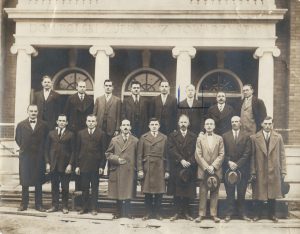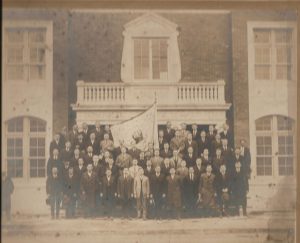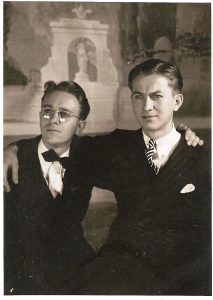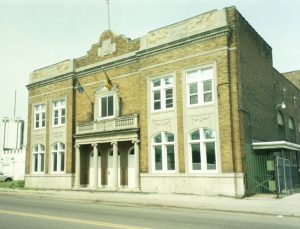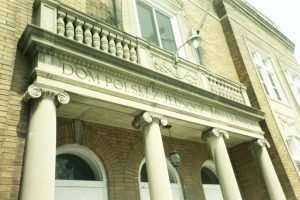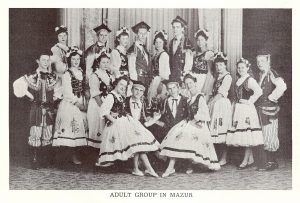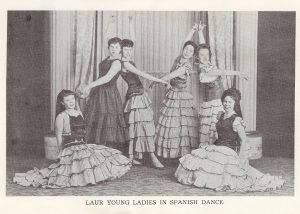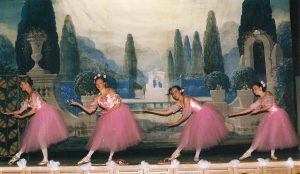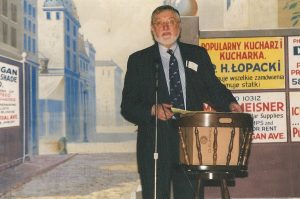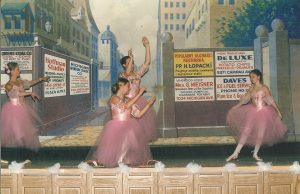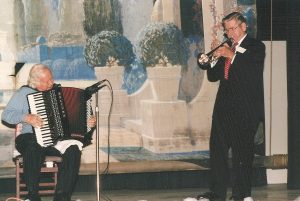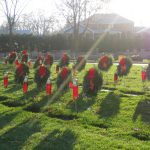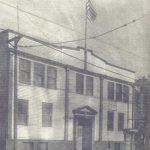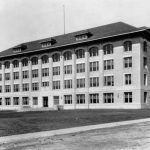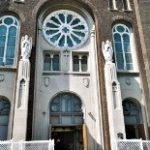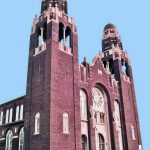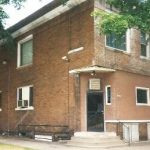A History of the West Side Detroit Dom Polski
3426 Junction Avenue, Detroit 48210
Introduction
The west side Dom Polski is perhaps the predominant architectural feature of west side Detroit’s Polonia. It served as a social and cultural hub for Detroit’s west side Polish neighborhoods from its construction in the early 20th century throughout the 1960s. It is significant because it was within the walls of the grand structures such as the theaters and cultural centers that first-generation Polish Americans elevated themselves—not only artistically and culturally, but also intellectually.
Built in two stages, in 1916-17 and 1925, the building was designed by one of Detroit’s Polish-born architects, Joseph Julius Gwizdowski, who is best known for designing Polish churches, municipal buildings, and cultural institutions in Detroit and other American cities.
The west side Dom Polski boasted an auditorium with galleries, a seating capacity of approximately 1,000, a fully equipped stage, and office quarters. The rear portion of the building, consisting of three levels of office space, was dedicated on July 5, 1917. The remainder of the magnificent structure was completed on September 15, 1925. For decades, it was considered the pride of Junction Avenue.
The second cornerstone of the Dom Polski, which is closest to Junction Avenue, reads Jedność i zgoda to siła nasza (Unity and Harmony are Our Strength). A pair of Ionic columns support a portico frieze above the Dom Polski’s doors, which bears the inscription Dom Polski z jedność towarzystw (loosely translated, Dom Polski United Societies).
The West Side Detroit Polish American Historical Society was responsible for obtaining a listing for the west side Dom Polski in the National Register of Historic Places on September 15, 2006.
Part I
Formation
The idea of a west side Dom Polski originated in 1909 with two lodges of the Polish National Alliance (P.N.A.). They were Lodge 649 St. Isadore’s Society and Lodge 1009 St. Cecilia’s Society. A temporary committee was formed, but due to insufficient finances, plans for moving forward were delayed for several years. Meanwhile, on December 8, 1912, the cornerstone was laid for the east side Dom Polski at 2281 Forest, just west of Chene Street.
In 1913, a permanent west side Dom Polski committee was formed, and the following officers were elected: W. Nizinski, President; B. Dronka, Vice President; A. F. Brzezinski, Secretary; J. Rempala, Financial Secretary; and S. Polzninski, Treasurer.
In May of that year, two parcels of land were purchased, and the organization was incorporated as the Polish United Societies Hall. An energetic fundraising program was conducted, which elicited the participation of new lodges and organizations.
In 1916, construction on the first part of the building began. The rear portion, consisting of three levels, was completed and dedicated on July 5, 1917. That became the headquarters of the Polish United Societies.
Through the continued efforts of many organizations and individuals, the building was paid for, and plans were made to raise more funds to develop the structure into its present state.
On September 15, 1925, the building was completed and was considered the pride of Junction Avenue. During this period, times were good, and the organization prospered. Steady income from rental of the building and other services enabled the debt to be repaid in a timely manner. But that quickly changed when the Depression of 1930 struck. Revenue dwindled, and there was not enough income to cover operating expenses. Mortgage payments could not be met, and the bank took possession of the building and listed it for sale. Fortunately, there were no buyers at the time.
The board of directors, under the leadership of Jacob Pawlowski, worked out an agreement with the bank whereby for a monthly rental payment the Polish United Societies could use the building with an option to buy. However, the option could not be exercised because the Polish United Societies could not meet the high demands of the bank’s receiver.
Finally, through the combined efforts of the board of directors and top officers of the P.N.A., whose Treasurer, J. S. Siker, had banking connections, a deal was consummated with the bank liquidators, and the building was finally purchased for $28,000—about half of what the liquidators originally demanded.
It was during the Depression that many societies withdrew from the Polish United Societies, and there were only four organizations remaining. Those were the St. Isadore’s Society Lodge 649 P.N.A., St. Cecilia’s Society Lodge 1009 P.N.A., St. Hedwig Cadets Posts Pulaski Legion, and Strength in Unity Society Lodge 2669 P.N.A.
An appeal was made to the lodges for financial assistance. It was at that time that Council 54 P.N.A. and St. Stanislaus and St. Felix Society Lodge 425 P.N.A. joined the Polish United Societies. At the time of its 25th Jubilee, the officers of the Polish United Societies were Jacob Pawlowski, President; Michael Sokol, Vice President; Albert Bem, Secretary; Albert Lazar, Financial Secretary; and Peter Madej, Treasurer. The mortgage was paid off, and a mortgage burning ceremony was held on November 26, 1944.
In the late 1950s and early 1960s, under the presidency of Maria F. Cichowicz, the building was restored. Murals were painted, a new floor was laid in the main hall, the stage was renovated, and new drapes and curtains were installed. Improvements in the kitchen were also made, and the building prospered.
Throughout the succeeding years, many cultural events were staged at the Dom Polski. Dances were held regularly, and patriotic and political rallies were conducted for the benefit of local residents. The songs, dances, and music of the land of our forefathers could be heard echoing through the halls. The youth group of Council 54 P.N.A. had its weekly singing, dancing, and Polish language and history classes at the Dom Polski. The board of directors continued to strive to improve the facilities in order to meet demands. With that in mind, a second kitchen was installed on the main level. The heating system was upgraded, and aesthetic enhancements were made.
In its 50th year, the Polish United Societies was composed of the following: St. Isadore Society Lodge 649 P.N.A., St. Cecilia Society Lodge 1009 P.N.A., St. Hedwig Cadets Post 5 Pulaski Legion of America, Strength in Unity Society Lodge 2669 P.N.A., and Council 54 P.N.A. The officers were Theodore Wilk, President; Walter Wiater, Vice President; Walter Lis, Secretary; and John Sobania, Treasurer.
On March 31, 1968, the 50th Jubilee of the west side Dom Polski was celebrated. With great pride and joy the board of directors expressed its gratitude to the membership, merchants, dealers, professionals, the Polish Daily Press, the Polish Radio Program, the West Side Courier, and the entire Polish community. The board of directors asked the community for their continued patronage and support in reliance upon their record of service to the community.
Part II
Joseph Julius Gwizdowski, Architect
There were a small number of Polish-American architects practicing in Detroit in the early 1900s. The first appears to have been the Kashubian-born Jozef G. Kosicki, who practiced under the anglicized name of Joseph G. Kastler in partnership with W. E. N. Hunter (Robert Christensen, “Significance” Section of National Register of Historic Places Form 10-900-a, April 2006). Joseph Julius Gwizdowski, the architect of both the front and rear portions of the west side Dom Polski, was another.
Joseph Julius Gwizdowski was born on July 7, 1880, in Gwizdów, Galicia, in the southeastern region of Poland, which was then occupied by the Austro-Hungarian Empire. He was the son of Antoni Gwizdowski, a farmer, and Agnes Czerwinska, and was the younger brother of Jan Adam Gwizdowski. In 1900, Joseph graduated from the State Technical Institute in Lemberg, Austria (Polish: Lwów, Ukraine: Lviv) and worked for the Austrian government supervising the construction of railroad stations.
In 1904, Joseph immigrated to the United States and settled in Chicago, where he was enrolled at Loyola University. He was employed by the architectural firm of Worthman and Stienbach, and later, the firm of W. B. Hartigan. He designed and was involved in the construction of numerous residential buildings while with Worthman and Stienbach and also served as building construction supervisor for the Worthman firm in Hammond, Indiana.
In 1914, Gwizdowski relocated to Detroit and, in that year, married Stephania Koscinski (1884 – 1959). In 1915, he designed the west side Dom Polski at 3426 Junction.
Part III
Noteworthy Historical Events
Political History
A remarkable event in automotive history took place at the west side Dom Polski on an otherwise quiet Sunday afternoon in 1936. On December 13, in the midst of a sit-down strike by plant workers at the Kelsey-Hayes Wheel Company in Detroit that had been staged on December 11, Walter Reuther was in town with his own agenda. Having arrived in Detroit in September and having established Local 174 of the U.A.W., he was attempting to organize and recruit workers for the Local. Reuther was organizing meetings in the primarily Polish neighborhood halls, including the west side Dom Polski.
Kelsey-Hayes officials announced a mass employee meeting that was to be held at the west side Dom Polski on the afternoon of Sunday, December 13, in an attempt to squelch support for the strike and to try to regain control of its employees. However, Reuther and Local 174 called its own meeting that same morning at the Falcons Hall (Nest 79), at 4130 Junction, north of Michigan Avenue near Buchanan. Nest 79 was a key cultural and educational site in the west side Polish community.
On the afternoon of December 13, 1936, it was reported that Reuther and his fellow organizer Richard Frankensteen, along with five hundred unionists, marched from the Falcons Hall over to the Dom Polski and onto the podium, overtaking the Kelsey-Hayes officials. That day, there were perhaps thousands in the now-historic hall, which then was referred to as “the pride of Junction Avenue.” After this fanfare by Reuther and his cohorts, Local 174 found itself with hundreds of new members (Robert Christensen, “Significance” Section of National Register of Historic Places Form 10-900-a, April 2006).
Cultural History
Beginning in 1927, the Laur Dancing Society had its headquarters in the Dom Polski. The Society was undoubtedly one of the most important west side Detroit cultural organizations. It was organized on February 6, 1927, and incorporated in March 1931. It derived its name from the laurel wreath, which the Society believed symbolized “tireless work and victory.”
Antoni Bielak was the first president of the Laur Dancing Society and served from 1927 through 1930.
The Society was formed for “the enrichment of American culture through cultivation, preservation, and propagation of Polish heritage in language, song, dance, drama and literature” (Laur Dancing Society’s 25th Anniversary Presentation Program, April 25, 1952).
The Society held a 25th anniversary presentation on Sunday, April 27, 1952, at Chadsey High School. Referring to the Society’s ideal, the program states that it is possible “because it is based upon the conviction that there are enormous possibilities in ordinary people.” During the 1950s, in addition to specializing in Polish dance, the Society’s professional instructors and ballet masters taught tap, ballet, Spanish and adagio. At that time, the Society was recognized as the leading Polish dancing society in the Midwest.
Joseph A. Wytrwal, Ph.D. (October 24, 1924 – August 26, 2016), educator and author, served as president of the Laur Dancing Society from 1949 through 1952. Dr. Wytrwal wrote an article about the Polish ballet in the Society’s 25th Anniversary program and explained that the ballet appeared in Poland during the 18th century and thrived in Poland “long before it was accepted in Germany and Russia” (Joseph A. Wytrwal, “The Polish Ballet”).
The Laur troupe performed in Bay City, Michigan, at the Jubilee Celebration of the Chopin Choir, as well as performing in the opera Halka, which was staged in Chicago and Detroit. In Bay City, Chicago, and Detroit, “the Society was acclaimed as the leading Polish ballet troupe” (Laur Dancing Society’s 25th Anniversary Presentation Program, April 25, 1952).
In March 1952, the Society took part in the Jean J. Jalmuzyński Soiree held at the Masonic Temple in Detroit. Jean J. Jalmuzyński was a highly revered dance instructor who taught dance both on the east and west sides of Detroit. Many of the dancers who appeared on the early-1950s television show Club Polka, on which west side accordionist and founding president of the West Side Detroit Polish American Historical Society, Staś Wiśniach, was orchestra leader, took lessons from Jalmuzyński, who had a dance studio on Forest and Grandy on the east side.
Even during the partitions, Wytrwal wrote, the ballet was as popular in Poland as the other arts. It was during that time that the Warsaw School became a renowned art center. So great were the male and female classical Polish dancers who studied at the Warsaw Ballet School that they were often summoned by the great court theaters in Moscow and St. Petersburg.
Among the greatest dancers was Matylda Krzesińska who, wrote Wytrwal, “eclipsed all other stars for many years” (Ibid).
In more recent times, as part of a celebration commemorating the west side Dom Polski’s listing in the National Register of Historic Places, on Sunday, May 15, 2005, the Piast Institute, in conjunction with the West Side Detroit Polish American Historical Society (under the auspices of the West Side Detroit Dom Polski Historical Society), hosted an event at the historic building entitled Oczepiny (Unveiling). The event included a literal unveiling of the Dom Polski. During the opening ceremony, ballet dancers from the Detroit Ballet, dressed in pink satin and tulle, entered en pointe and wove their way through the aisles of seated patrons in the grand ballroom carrying with them a long veil of white tulle. In keeping with the theme, the outside of the building, also, was draped in white tulle to symbolize the unveiling.
Rev. Robert C. Wojciechowski, Pastor of St. Hedwig parish at the time, blessed the Dom Polski.
The traditional ceremonial wedding number Oczepiny, which was played by Polish-American bands at wedding receptions in the early 20th century, was performed by accordionist and founding president of the West Side Detroit Polish American Historical Society, Staś Wiśniach, and trumpeter Wally Duda. A champagne and hors d’oeuvres reception followed, catered by Noel Buday.
The esteemed Thaddeus C. Radziłowski, Ph.D., co-founder along with Ms. Virginia Skrzyniarz of the Piast Institute in Hamtramck, gave a lecture entitled “Polish Immigrants in Detroit.”
The featured performance was by four lovely young ballerinas from the Detroit Ballet: Sara Rivera, Marisa Samosiuk, Kerry Greaves, and Sally Wood. Under the direction of ballet master Eric Johnston, the dancers delighted the crowd of approximately 175 patrons. For the event, Director Johnston resurrected and choreographed a long-lost ballet, which was renamed Różowy szampan: Taniec na cztery dziewczyny (Pink Champagne: Dance for Four Girls). Ballet aficionados recognized it as the classic pas de quatre, divertissement. Original choreography was by Jules Perrot. Cesare Pugni composed the music. The piece was first presented at His Majesty’s Theatre in London on July 12, 1845, at a time when, coincidentally, the polka was all the rage in Paris.
The event featured for the first time in nearly 60 years the unveiling of two magnificent stage backdrops.
At one time, early in the Society’s formation, the West Side Detroit Polish American Historical Society (founded in 2006) was considering the Dom Polski as its headquarters. The Society ultimately was headquartered in St. Hedwig parish at 3245 Junction in Detroit beginning in 2006, where Adam Lis, an original Society director, served as the parish’s archivist and historian. Following the passing of Staś Wiśniach in 2007, Mr. Lis served as the Society’s president until Rev. Gary Michalik assumed the position of president in 2012. At that time, the Society relocated its headquarters to St. Colette parish in Livonia, where Rev. Michalik serves as pastor.
Part IV
The West Side Dom Polski in Modern Times
As of 2020, the Dom Polski has been privately owned for many years.
At a meeting of the board of the State Historical Commission in Lansing, Michigan, on September 15, 2006, the Dom Polski was officially declared a national historic building. The nomination was made by the West Side Detroit Polish American Historical Society, which initiated the process in late 2004. As a result, the Dom Polski received listing in the National Register of Historic Places.
Note re Sources:
On Sunday, May 15, 1955, Council 54 P.N.A. held its Diamond Jubilee Youth Festival at the west side Detroit Dom Polski at 3426 Junction Avenue. Subsequently, on Sunday, March 31, 1968, the west side Dom Polski board of directors held its Golden Jubilee (1918 – 1968) at the Dom Polski.
Part I of this history was compiled by Laurie A. Gomulka in August 2007 and updated in June 2020. Its original contents were derived from the 1918 – 1968 West Side Dom Polski Board of Directors Golden Jubilee program brochure. The remainder of Part I was written by Joseph C. Rychlicki, President, Council 54, P.N.A. [It has been slightly modified.]
Part II was added to this historical compilation in August 2007 by Laurie A. Gomulka. The information regarding the Dom Polski’s architect, Joseph J. Gwizdowski, was provided by the architect’s grandson, Joseph P. Whistler of Warrenton, VA.
Part III was added to this historical compilation in August 2007 by Laurie A. Gomulka using the following sources: Information from Robert Christensen’s research, compiled for and provided in the “Significance” section of the State of Michigan National Register of Historic Places Form 10-900-a (April 2006); Laur Dancing Society’s 25th Anniversary Presentation Program (April 25, 1952); and Laur Dancing Society’s 25th Anniversary Presentation Program – Chadsey High School (April 27, 1952)
Part IV was added to this historical compilation in June 2020 by Laurie A. Gomulka.
Photos:
- West Side Dom Polski exterior. Pictured: 17 members of one of the Dom Polski’s founding societies, each of whom donated $25.00 towards the construction of the Dom Polski (ca. 1925). Top, third from left: Jacob Bobowski; fourth from left: Mr. Juszczyk; fifth from left: Valenty Janiczek; sixth from left: Louis Jonik; Bottom row: fourth from left: Mr. Ruchin; fifth from left: Joe Potzeba; sixth from left: Albert Sajdak. Source: WSDPAHS archives, courtesy of Brian Jones
- West Side Dom Polski exterior featuring members of a men’s Polish organization (ca. 1930). Source: Collection of Laurie A. Gomulka, courtesy of Dr. Edward F. Martin
- Clarinetist Ted Lach and trumpeter Ted Gomulka on the stage of the west side Dom Polski (1935). Source: Collection of Laurie A. Gomulka
- Dom Polski exterior (ca. 2003). Photo: Laurie A. Gomulka
- Dom Polski exterior, close-up (ca. 2003). Photo: Laurie A. Gomulka
- Laur Dancing Society – Mazur (1959). Source: Collection of Laurie A. Gomulka, courtesy of Chris Unwin
- Laur Dancing Society – Spanish Dance (1959). Source: Collection of Laurie A. Gomulka, courtesy of Chris Unwin
- Members of the Detroit Ballet performing on the stage of the west side Dom Polski at the Oczepiny (Unveiling) event presented by the Piast Institute, in conjunction with the West Side Detroit Polish American Historical Society (under the auspices of the West Side Detroit Dom Polski Historical Society) (May 15, 2005). The garden scene backdrop is visible in the background. Source: WSDPAHS archives, courtesy of Laurie A. Gomulka
- Thaddeus C. Radziłowski, Ph.D., presenting a lecture on the stage of the west side Dom Polski (May 5, 2015). The street scene backdrop is visible in the background. Source: WSDPAHS archives, courtesy of Laurie A. Gomulka
- Members of the Detroit Ballet performing on the stage of the west side Dom Polski with the street scene visible in the background (May 15, 2005). Source: WSDPAHS archives, courtesy of Laurie A. Gomulka
- Accordionist Staś Wiśniach and trumpeter Wally Duda performing on the stage of the west side Dom Polski (May 15, 2005). Source: WSDPAHS archives, courtesy of Laurie A. Gomulka
